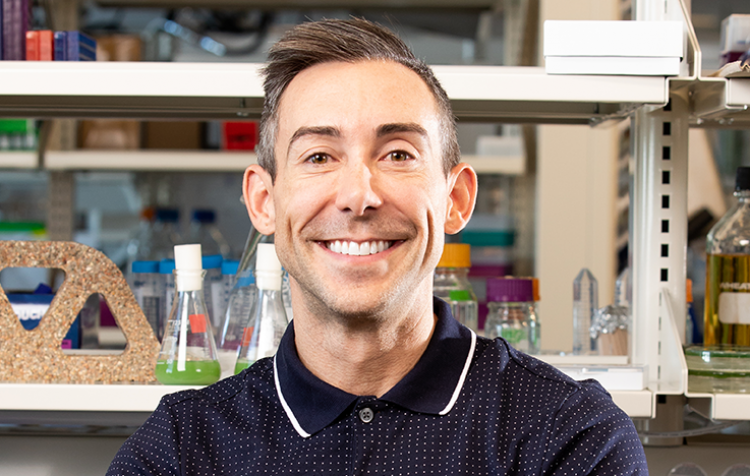May 28 2020
Proteins that safeguard animals and plants from freezing under extremely cold temperatures could be the key to cementing the sustainability of future infrastructure.
 Wil Srubar III. Image Credit: CU Boulder.
Wil Srubar III. Image Credit: CU Boulder.
Researchers at CU Boulder have identified the ability of a synthetic molecule based on natural antifreeze proteins to reduce freeze-thaw damage and increase the durability and strength of concrete. This could enhance the longevity of new infrastructure and decrease carbon emissions over its lifetime.
They discovered that the addition of a biomimetic molecule—mimicking antifreeze compounds found in the Arctic and Antarctic organisms—to concrete effectively inhibits the growth of ice crystal growth and the resulting damage. This new technique, reported recently in Cell Reports Physical Science, challenges over 70 years of traditional methods used to mitigate frost damage in concrete infrastructure.
No one thinks about concrete as a high-tech material. But it’s a lot more high-tech than one might think. In the face of climate change, it is critical to pay attention to not only how we manufacture concrete and other construction materials that emit a lot of carbon dioxide in their production, but also how we ensure the long-term resilience of those materials.
Wil Srubar III, Study Author and Assistant Professor of Civil, Environmental and Architectural engineering, University of Colorado Boulder
Concrete is prepared by combining cement powder, water, and other aggregates such as gravel or sand.
From the 1930s, small air bubbles have been incorporated into concrete to safeguard it from damage due to water and ice crystal. This offers room for any water seeping into the concrete to expand upon freezing. In the absence of air bubbles, the damaged concrete’s surface tends to flake off.
However, this fussy process could decrease the concrete strength and increase its permeability. This could make way for leaching of road salts and other chemicals into the concrete, which can consequently deteriorate steel embedded within.
“While you’re solving one problem, you’re actually exacerbating another problem,” noted Srubar.
With the United States facing a considerable amount of aging infrastructure throughout the country, the country spends billions of dollars annually to prevent and mitigate damage. However, this new biomimetic molecule could drastically reduce costs.
During tests, it was found that concrete synthesized using this molecule—rather than air bubbles—exhibits higher strength, equivalent performance, a longer lifespan, and lower permeability.
With a pending patent, Srubar hopes that this new technique will make it to the commercial market within 5 to 10 years.
Nature Finds a Way
Spanning from the ice-cold tundras of the Arctic to the below-freezing waters of Antarctica, several fish, plants, bacteria, and insects contain proteins that protect them against freezing. Such antifreeze proteins in an organism bind to the ice crystal surface as soon as they form—maintaining them extremely small, such that they cannot do any damage.
“We thought that was quite clever,” added Srubar. “Nature had already found a way to solve this problem.”
Concrete is hampered by the same problem of ice crystal formation, which engineers had previously tried to mitigate by adding air bubbles. Therefore, Srubar and his colleagues thought: Why not collect a bunch of this protein, and incorporate it into concrete?
Sadly, these natural proteins, which do not like to be removed from their natural environments, tend to disintegrate or unravel, similar to overcooked spaghetti. Moreover, concrete is extremely basic, with a pH usually over 12 or 12.5. For most molecules, this is not a pleasant environment and the proteins were no exception.
Therefore, Srubar and his graduate students employed a synthetic molecule called polyvinyl alcohol (PVA) that acts exactly like the antifreeze proteins but exhibits higher stability at a high pH.
They blended it with another robust, non-toxic molecule—polyethylene glycol—used more in the pharmaceutical industry to extend the time taken by drugs to circulate in the body. At a high pH, this molecular combination of two polymers was stable and prevented the growth of ice crystals.
Increased Stressors
Concrete is the second most consumed material on Earth, next only to water, with two tons of concrete manufactured per person each year. According to Srubar, that is equivalent to a new New York City built for every 35 days for at least the next 32 years.
Its manufacture, use and disposal have significant environmental consequences. The production of cement alone, the powder that we use to make concrete, is responsible for about 8 percent of our global CO2 emissions.
Wil Srubar III, Study Author and Assistant Professor of Civil, Environmental and Architectural engineering, University of Colorado Boulder
To fulfill Paris Agreement goals and maintain global temperature increase well below 3.6 °F, emissions from the construction industry should be reduced to 40% by 2030 and it should be eliminated totally by 2050. Climate change itself will only intensify the stressors on concrete and aging infrastructure, with higher extreme temperatures and freeze and thaw cycles taking place more often in certain geographic locations.
The infrastructure which is designed today will be facing different climatic conditions in the future. In the coming decades, materials will be tested in a way they’ve never been before. So the concrete that we do make needs to last.
Wil Srubar III, Study Author and Assistant Professor of Civil, Environmental and Architectural engineering, University of Colorado Boulder
Source: https://www.colorado.edu/